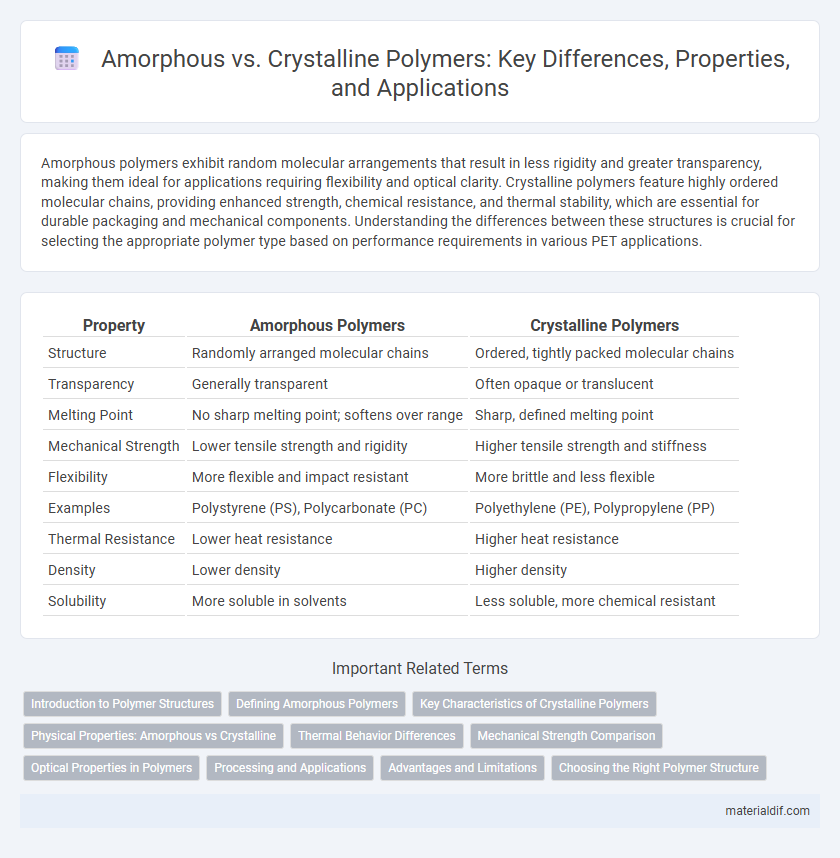Amorphous polymers exhibit random molecular arrangements that result in less rigidity and greater transparency, making them ideal for applications requiring flexibility and optical clarity. Crystalline polymers feature highly ordered molecular chains, providing enhanced strength, chemical resistance, and thermal stability, which are essential for durable packaging and mechanical components. Understanding the differences between these structures is crucial for selecting the appropriate polymer type based on performance requirements in various PET applications.
Table of Comparison
| Property | Amorphous Polymers | Crystalline Polymers |
|---|---|---|
| Structure | Randomly arranged molecular chains | Ordered, tightly packed molecular chains |
| Transparency | Generally transparent | Often opaque or translucent |
| Melting Point | No sharp melting point; softens over range | Sharp, defined melting point |
| Mechanical Strength | Lower tensile strength and rigidity | Higher tensile strength and stiffness |
| Flexibility | More flexible and impact resistant | More brittle and less flexible |
| Examples | Polystyrene (PS), Polycarbonate (PC) | Polyethylene (PE), Polypropylene (PP) |
| Thermal Resistance | Lower heat resistance | Higher heat resistance |
| Density | Lower density | Higher density |
| Solubility | More soluble in solvents | Less soluble, more chemical resistant |
Introduction to Polymer Structures
Amorphous polymers consist of randomly arranged molecular chains lacking a definite geometric pattern, resulting in transparency and flexibility but lower density and melting points. Crystalline polymers exhibit highly ordered and tightly packed molecular chains, which enhance mechanical strength, chemical resistance, and thermal stability due to increased crystallinity. Understanding the balance between amorphous and crystalline regions is crucial for tailoring polymer properties in applications ranging from packaging to engineering plastics.
Defining Amorphous Polymers
Amorphous polymers consist of polymer chains arranged in a random, disordered manner without a defined crystalline structure, resulting in materials that are typically transparent and flexible. These polymers lack sharp melting points and soften over a temperature range, characterized by their glass transition temperature (Tg). Common examples include polystyrene and polycarbonate, which exhibit unique mechanical properties due to their non-crystalline molecular arrangement.
Key Characteristics of Crystalline Polymers
Crystalline polymers exhibit a highly ordered molecular structure characterized by tightly packed polymer chains forming distinct crystalline regions. This ordered arrangement results in enhanced mechanical strength, higher melting points, and increased chemical resistance compared to amorphous polymers. Common examples of crystalline polymers include polyethylene (PE), polypropylene (PP), and nylon, which are widely used in applications requiring durability and thermal stability.
Physical Properties: Amorphous vs Crystalline
Amorphous polymers exhibit random molecular arrangements resulting in lower density, transparency, and flexibility with a broad softening temperature range. Crystalline polymers possess ordered molecular structures that provide higher density, enhanced tensile strength, stiffness, and a sharp melting point. The degree of crystallinity directly influences thermal resistance, impact strength, and chemical resistance in polymer materials.
Thermal Behavior Differences
Amorphous polymers exhibit a gradual softening over a temperature range due to their random molecular arrangement, characterized by a glass transition temperature (Tg). Crystalline polymers display a sharp melting point (Tm) because of their ordered molecular structure, resulting in a well-defined phase change. The thermal behavior of amorphous polymers is dominated by increased molecular mobility above Tg, while crystalline polymers require higher energy input to disrupt their crystalline regions during melting.
Mechanical Strength Comparison
Crystalline polymers exhibit higher mechanical strength due to their ordered molecular structure, which facilitates strong intermolecular forces and tight chain packing, resulting in increased tensile strength and stiffness. Amorphous polymers have a disordered arrangement, leading to lower mechanical strength but greater impact resistance and flexibility. The degree of crystallinity directly influences properties such as modulus, yield strength, and hardness, with crystalline regions enhancing these mechanical attributes.
Optical Properties in Polymers
Amorphous polymers exhibit high optical clarity due to their random molecular arrangement, which minimizes light scattering and enables excellent transparency. Crystalline polymers possess ordered regions that disrupt light transmission, causing opacity or translucence depending on the degree of crystallinity. The optical properties of polymers are therefore directly influenced by their molecular structure, with amorphous polymers favored in applications demanding clear optical performance.
Processing and Applications
Amorphous polymers exhibit random molecular chains that allow for easier processing through injection molding and extrusion due to their lower melting points and greater flexibility. Crystalline polymers, characterized by tightly packed molecular chains, require precise temperature control and slower cooling rates to achieve optimal crystallinity, enhancing mechanical strength and chemical resistance. Applications of amorphous polymers include transparent lenses and packaging films, while crystalline polymers are preferred in automotive parts and high-performance fibers for their durability and thermal stability.
Advantages and Limitations
Amorphous polymers offer excellent clarity, impact resistance, and ease of processing due to their random molecular arrangement, but they often exhibit lower chemical resistance and thermal stability compared to crystalline polymers. Crystalline polymers provide higher mechanical strength, chemical resistance, and thermal durability as a result of their ordered molecular structure, though they tend to be more brittle and less transparent. Selecting between amorphous and crystalline polymers depends on specific application requirements such as flexibility, toughness, thermal performance, and optical clarity.
Choosing the Right Polymer Structure
Amorphous polymers feature randomly arranged molecular chains, offering transparency and flexibility ideal for applications requiring impact resistance and ease of molding. Crystalline polymers possess highly ordered structures, granting superior strength, chemical resistance, and thermal stability suitable for high-performance engineering parts. Selecting between amorphous and crystalline polymers depends on balancing mechanical properties, optical clarity, and processing conditions to meet specific application demands.
Amorphous vs Crystalline Polymers Infographic

 materialdif.com
materialdif.com